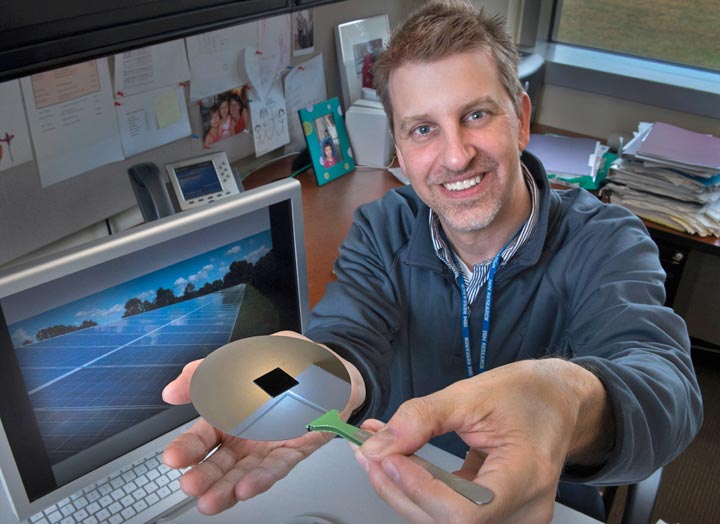Etching Maximizes the Sun's Rays
March 17, 2015

Chuck Black displays a nanotextured square of silicon on top of an ordinary silicon wafer. The nanotextured surface is completely antireflective and could boost the production of solar energy from silicon solar cells.
Reducing the amount of sunlight that bounces off the surface of solar cells helps maximize the conversion of the sun's rays to electricity, so manufacturers use coatings to cut down on reflections. Now scientists at the U.S. Department of Energy's Brookhaven National Laboratory show that etching a nanoscale texture onto the silicon material itself creates an antireflective surface that works as well as state-of-the-art thin-film multilayer coatings.
Their method has potential for streamlining silicon solar cell production and reducing manufacturing costs. The approach may find additional applications in reducing glare from windows, providing radar camouflage for military equipment, and increasing the brightness of light-emitting diodes.
"For antireflection applications, the idea is to prevent light or radio waves from bouncing at interfaces between materials," said physicist Charles Black, who led the research at Brookhaven Lab's Center for Functional Nanomaterials (CFN), a DOE Office of Science User Facility.
Preventing reflections requires controlling an abrupt change in "refractive index," a property that affects how waves such as light propagate through a material. This occurs at the interface where two materials with very different refractive indices meet, for example at the interface between air and silicon. Adding a coating with an intermediate refractive index at the interface eases the transition between materials and reduces the reflection, Black explained. "The issue with using such coatings for solar cells," he said, "is that we'd prefer to fully capture every color of the light spectrum within the device, and we'd like to capture the light irrespective of the direction it comes from. But each color of light couples best with a different antireflection coating, and each coating is optimized for light coming from a particular direction. So you deal with these issues by using multiple antireflection layers. We were interested in looking for a better way."
To learn more about this exciting research visit: www.bnl.gov/newsroom/news.php?a=11685
2015-5590 | INT/EXT | Newsroom









